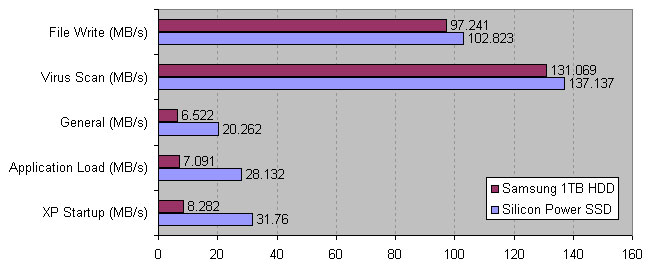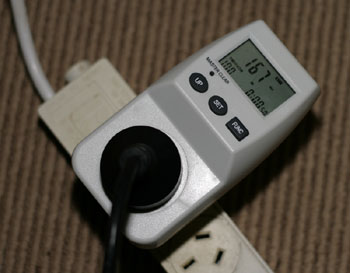PCMark05, Power, Heat, Noise, Conclusions
The last benchmark we'll use is FutureMark's PCMark05, in particular the HDD Test suite. The successor to this, PCMark Vantage, was not used because it requires Vista. The HDD Test suite consists of various activities simulating real-world usage, summarised into four categories. You can see the full details on page 17 of this PDF.

Here we see a similar picture to the previous results. The SSD ranges from only slightly beating the HDD to convincingly beating it.
Image Conversion:
As a last real-world test, we used the FastStone Image Viewer to batch-convert 400 wedding photos, totalling 1GB, from their native 3888 x 2592 resolution to a more web-friendly 800x600 lower-quality jpg, saved in a subdirectory. Remember again, for each test, the Silicon Power 64GB SSD -OR- the Samsung 1TB HDD is the only drive in the system. So the operating system, applications, photo data and any virtual memory access is all happening on the same drive.
I'm not going to bother making a graph for this one: both drives scored the same, to the second. 9 minutes and 28 seconds, as it happens. Presumably we are CPU limited there by the single-threaded conversion task, even at 3GHz. By trying different image sizes and "easier" options for the conversion I was eventually able to show a 4 second advantage to the HDD, but realistically, all this test proves is that neither drive is slow enough to be a bottleneck for this kind of work.
Performance Summary:
There's been a lot of graphs and numbers so far, but one thing is clear, there is certainly no performance disadvantage to going to SSD, for any kind of normal or common usage. In many situations you can see a performance improvement from the SSD. Unless you're hammering the drive with random writes, like a busy database server, I'd have no problem recommending this drive.
Power Consumption, Heat, Noise:
Modern hard drives are very quiet, it has to be said. Samsung in particular have earned themselves a bit of a name for cool quiet drives and the recent ones have much less of a performance penalty than the first few from them. But this seems to be one of those things you only notice when it's not there any more. When swapping the drives back and forth in our single-drive testbed, I was definitely aware of noise from the platter-based hard drive. A low, almost subterranean grinding sound during access and a very faint whine of the motor at other times. In a poorly designed case this vibration can resonate and be amplified, and other higher-performance drives can be even worse, especially after a few years when the bearings start to whine. The solid-state drive, on the other hand, makes no noise at all. None. There are no moving parts. It's almost unnverving to see the hard drive light flickering and have absolutely no corresponding noise or vibration.
Heat is another concern with hard drives, of course. Virtually all 7200rpm hard drives will become unpleasantly hot to the touch if left in stagnant air, even when only idling. The SSD, even during benchmarking, got only barely noticeably warm. Honestly, you have to really think about whether it's actually warmer than the ambient temperature or not. This is one of the most impressive aspects of SSD technology to me, and it brings us back to noise. How much of the airflow and associated noise in your case is to keep your hard drive(s) cool? You could quite seriously duct-tape an SSD to the back of your motherboard tray and forget about it. The heat issue is just gone.
Heat of course brings us finally to power consumption. There's no rocket science to this, I just used a wall-plug energy meter (a "Power Tech Plus MS-6115") which can display the current wattage being used, as well as recording the maximum used over a given set of testing.

I connected the meter to the PSU power cord, which doesn't include the monitor's power. Booting the machine off the SSD, giving the machine a minute to idle so I could record an idle load, then copying our 552MB test image and 507MB of photos from the SSD to itself, and then shutting down. The idle desktop load, load during file copying and maximum load were recorded. The SSD was swapped with the 1TB Samsung drive and the test repeated.

Across the board the PC uses less power when using the SSD than when using the HDD, which is no surprise. The greatest drop is of course during the file copy when presumably the hard drive's heads are working hard to read and then write chunks of data. The savings aren't huge, but they're more than 5%. Remember, that's 5% of the entire PC's power usage, including a 3GHz quad-core CPU and 9800GT video card etc. If you were building a PC from scratch with energy efficiency in mind, the percentage gain from an SSD would be higher.
Pricing and Final Thoughts
A quick sniff around shows the Silicon Power 64GB 2.5" SSD available around Australia at about the $270 mark. For comparison a 300GB VelociRaptor is around $400, a 1TB 7200rpm drive is around $180 and a 250GB 2.5" laptop hard drive is about $120. So the pricing is certainly within the same ball-park, but you do of course pay more per GB and more per MB/s than platter-based options, as expected. But personally I think the pricing is at a very reasonable point already, and it's continuing to fall.
Update: Actually, the pricing I found seems likely to be for the MLC version of the drive, not SLC. I'm not sure how much price difference there will be for the SLC version, but it's likely to be significant. So bear that in mind, and remember to check part numbers and details with your retailer!
So. The more cynical among you will be saying "gosh Agg, this new technology lets me pay more money for roughly the same performance, slightly less power usage and a lot less capacity!" Well, yes. If you have a desktop system and need more storage, buy one of the 1TB drives you can almost find in cornflake packets nowadays. If you need speedy storage, a VelociRaptor or other high-performance platter-based drive may still be better value in terms of speed and capacity for your dollar. These oldschool solutions are still very workable if you can manage the noise and heat.
But I have to say, I come away from this first SSD experience feeling very positive. I expected to be apologetically saying how it's early days for the technology so bad performance is to be expected. But those days have already passed. The performance of this Silicon Power 64GB SSD is absolutely fine. I'd have no issues using this disk in my main PC, or in fact in almost any situation other than a database server (due to the random write performance). The complete absence of heat and noise is very appealing. If you have a laptop you'd be mad to get a platter-based storage upgrade now, unless you really need a lot of space or are saving your pennies.
It's an exciting time and I look forward to seeing how the technology continues to mature. Thanks again to Silicon Power for the opportunity!
|


